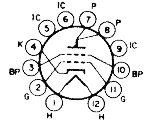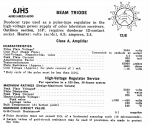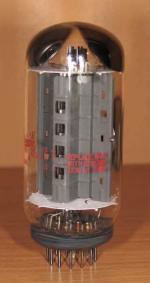
6JD5
|
|
|||||||||||||||||||||||||||||
|
Hits: 8684 Replies: 6
6JD5 Forward grid bias
|
|||||||||||||||||||||||||
|
Joe Sousa
21.May.11 |
1
Fellow Radiophiles, The 6JD5 high Voltage Beam triode came up in a conversation about the "chamber" types of anodes that are used to suppress secondary emission from the anode in power tetrodes. The 6JD5 does have a single deep "chamber" in it's anode and it has four active terminals, like a tetrode, but it was designed as a high mu=300 triode with beam shaping secondary emission suppressing plates. The intended application was as a pulse regulator for the high voltage supply in color TV sets, operating with 3kV at the 6DJ5 anode and a low duty cycle (2.5%) pulsed current of 300mA. HV regulation was very important in color TV sets in order to maintain proper convergence among the three color guns over a wide range of beam currents. The combination of high mu=300 and high power (35W max) recalls the Triple Twin operation of high mu power triodes in forward bias to obtain high efficiency and high linearity audio output power. This was described by Rolf Nickel in the Triple Twin German language thread, which I read with the google translator, but the attachments are already in English. The forward bias of the power triode increased efficiency to produce pentode-like curves, but with improved linearity because the driving cathode follower triode non-linearity cancelled the non-linearity of the power triode to a large degree. Also keep in mind that the forward bias region of the grid uses a smaller proportion of the quasi parabolic transconductance, which starts at cutoff. Another way to put it is that the forward bias region is quite far from the increased nonlinearity near cutoff. The following curves suggest that the 6JD5 may make a good audio power amplifier with 250V at the plate. The suppressor plates G2 were tied to the Anode for these plots. Forward bias of +6V at G1 dramaticaly increases plate current to 100mA in the first plot, from less than 2mA with G1=0V in the second plot. Note the very different vertical current scales in these plots. A key parameter in the Triple-Twin configuration is the input current into G1. The plot on the left shows a g1 input impedance around 200 Ohms. There is a low sensitivity of grid current to plate voltage as seen when A=G2=50V. It is not hard to find a tube that can drive up to 30mA into a ~200Ω load. Some care could be exercised to match the cathode non-linearity of this driving tube to the non-linearity of the loading grid current of the output tube. A driving tube with a nominal 5mS transconductance at 15mA would only need to swing 12Vp-p to swing the 6JD5 grid up to +6V. The following load line plot shows that 3.8W could be delivered to a 2.2kΩ single ended load. The damping of this load by the nominal 9kΩ plate impedance seen on the curves will not be as stiff, as a reverse biased triode would deliver, with a likely plate impedance under 1kΩ, but the linearity of the combined Triple-Twin should be superior. A push=pull AB configuration should deliver a clean 12W. A higher plate supply would increase the plate dissipation above the 12.5W of this load line, but under the rated 35W maximum, and would allow for a higher impedance transformer to be used for better damping against the 9k nominal plate impedance seen in the curves. The 6JD5 seems to be relatively inexpensive in an internet search. Regards, -Joe
|
||||||||||||||||||||||||
|
Robert Weaver
04.Jun.11 |
2
Hi Joe, This is a most interesting article. Thank you for posting it. I've recently been considering building an audio amplifier using inexpensive television tubes. Until now, I had been considering horizontal sweep pentodes. But this is a much more interesting idea. I note that there are several other beam triodes designed for pulse regulator service, such as the 6HS5, 6HV5 and 6HZ5. All are relatively low cost. These three require considerably less heater current than the 6JD5 which would make them easier to power up. Their other ratings are similar to the 6JD5, but it's possible that their internal structure may be different. Have you looked at any of these tubes? |
||||||||||||||||||||||||
|
Joe Sousa
04.Jun.11 |
3
Hi Bob: I am very glad that you are contemplating using these power triodes. Since the original post, I found from Eric Barbour that there was a small family of these tubes for the same application, and you already indentified a couple of these. Summarizing the essential characteristics of these tubes:
Another distinctive characteristic of these beam triodes is the relatively low Miller feedback capacitance from plate to grid, around 2pF. This figure is low due to the screening/shieding effect of the suppressor plates. This low capacitance helps facilitage high slew rates at the plate. Today I picked a used 6HV5A at Radio Activity. When I get home I plan to curve-trace it to see if there is any significant difference. Perhaps the largest difference I may see is signs of wear in this used tube. In a private email, Luwell Sibley pointed out the 12G8 dual triode wich was designed for 12V operation in the Tripple-Twin configuration as the driving amplifier to drive 25mW into a solid stage Germanium transistor output stage for car radios for the mid to late 1950's. This low voltage application highlights the inherent low voltage capability of the Tripple-Twin configuration. Please keep us posted with your efforts in designing an audio amp with this beam triode family. Regards, -Joe |
||||||||||||||||||||||||
|
Ernst Erb
05.Jun.11 |
4
Sorry, it is off topic, but you mentioned the 12G8 for 12V operation. |
||||||||||||||||||||||||
|
Joe Sousa
10.Jun.11 |
5
See 6HV5A forward grid bias for a performance comparison. There is an error in a label in the second plot shown above with negative grid drive. I repeat the plot here:
Where it reads g1=-2V, it should read g1=-200mV. The grid voltage is stepped -200mV/step.
Regards, -Joe |
||||||||||||||||||||||||
|
Joe Sousa
24.Jun.11 |
6
Fellow Radiophiles: This new 6JD5 by Dumont performs comparably to the new 6JD5 by Sylvania shown above. I have also curve traced other tubes in this family, including the 6JK5 6JH5 6HV5A and 6HS5. Some of these tubes differ in heater current. The 6HS5 also has a short 34mm plate, while the other tubes have 47mm long plates.
While all of these tubes would perform well as linear power amplifiers with forward control grid bias, the 6JD5 has the lowest plate knee, thus giving the widest possible plate swing. Regards, -Joe |
||||||||||||||||||||||||
|
Joe Sousa
30.Jun.11 |
7
Fellow Radiophiles: In a private email discussion with Bob Weaver, he found it curious that a 3kV rating at the anode could be sustained with a socket connection of the Anode. The EIA standard base 12GY calls for a single connetion to pin 7 in the duodecar base with two "IC" internally connected pins on both sides of pin 7 at locations 5,6,8,9. But the similar 12JE that is used by some of these triodes, has the anode connected to pins 7 and 8. The 12GY base is specified in the data sheet for the 6JD5 by GE, 6HS5 by RCA, 6HV5A by GE. The 12JE base is specified in the data sheet for the 6JH5 by GE, 6JK5 by GE. But these bases appear to be used interchangeably, at least for the 6JD5. For example, I have a Dumont 6JD5 with the 12GY base and a Sylvania 6JD5 with the 12JE base. The following photo shows the two variants above their respective boxes. The length and orientation of the internal portion of the "IC" pins also varies from type to type. Some of the "IC" pins away from the Anode, at locations 5 and 9, are bent internally away from the anode. All adjacent pins to the anode are internally short. Pin 5 of the 6HV5, 6JK5 and 6HS5 all terminate at the mica. Pin 5 is the first "x" on the left in the photos. I marked the anode pins with "A" and the "IC" pins with "x".
Best regards, -Joe |
||||||||||||||||||||||||
End of forum contributions about this tube
| Data Compliance | More Information |
















